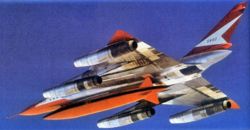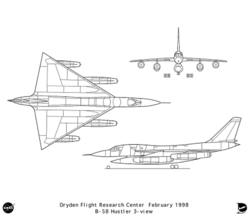PlaneSpottingWorld welcomes all new members! Please gives your ideas at the Terminal.
B-58 Hustler
| Convair B-58 Hustler | |
|---|---|
| Type | Strategic bomber |
| Manufacturer | Convair |
| Maiden flight | 1956-11-11 |
| Introduced | 1960-03-15 |
| Retired | 1970-01-31 |
| Primary user | United States Air Force |
| Number built | 116 |
| Unit cost | US$12.44 million[1] |
The Convair B-58 Hustler was a high-speed jet bomber capable of Mach 2 supersonic flight. The aircraft was developed for the Strategic Air Command of the United States Air Force during the late 1950s and was in service from 1960 to 1969.
It received a great deal of notoriety due to its sonic boom, which was often heard by the public as it passed overhead in supersonic flight.
Contents
Design
The B-58 had a delta wing with a leading-edge sweep of 60°. With four General Electric J79-GE-1 turbojet engines, it was capable of flying at twice the speed of sound. Although its large wing made for relatively low wing loading, it proved to be surprisingly well suited for low-altitude, high-speed flight. It seated three (pilot, bombardier/navigator, and defensive systems operator) in separated tandem cockpits, equipped with a novel ejection capsule that made it possible to eject at an altitude of 21,000 m (70,000 ft) at speeds up to Mach 2 (2,450 km / 1,320 mph), something impossible with standard ejection seats of the period.
The B-58 typically carried a single nuclear weapon in a streamlined MB-1C pod under the fuselage. From 1961 to 1963 it was retrofitted with two tandem stub pylons under each wing, inboard of the engine pod, for B43 or B61 nuclear weapons for a total of 5 nuclear weapons per airplane. A single M61 Vulcan cannon was mounted in a radar-directed tail turret for defense. Although the USAF explored the possibility of using the B-58 for the conventional strike role, it was never equipped for carrying or dropping conventional bombs in service. A photo-reconnaissance pod, the LA-331, was also fielded. Several other specialized pods for ECM or an early cruise missile were considered, but not adopted.
Operational history
The B-58 crews were elite, hand-picked from other strategic bomber squadrons. Due to some unique aspects of flying a delta-winged aircraft, the pilots used the F-102 Delta Dagger in their transition to the Hustler. The aircraft was difficult to fly and its three-man crews were constantly busy but the performance of the aircraft was exceptional. A lightly loaded Hustler would climb at nearly 46,000 ft/min (235 m/s), comparable to the best contemporary fighters, and it could cruise with a payload at 85,000 ft (26,000 m) (Higham 1975). Nevertheless, it had a much smaller weapons load and more limited range than the B-52 Stratofortress. It had been extremely expensive to acquire (in 1959 it was reported that each of the production B-58As was worth more than its weight in gold). It was a complex aircraft that required considerable maintenance, much of which required specialized equipment, which made it three times as expensive to operate as the B-52. Also against it was an unfavorably high accident rate: 26 aircraft were lost in accidents, 22.4% of total production. SAC had been dubious about the type from the beginning, although its crews eventually became enthusiastic about the aircraft (its performance and design were appreciated, although it was never easy to fly).
By the time the early problems had largely been resolved and SAC interest in the bomber had solidified, Secretary of Defense Robert McNamara decided that the B-58 was not going to be a viable weapon system. Its early retirement, slated for 1970, was ordered in 1965, and despite efforts of the Air Force to earn a reprieve, proceeded on schedule. The last B-58s in operational service retired January 16, 1970, largely replaced by the FB-111A 'Aardvark'. A total of 116 B-58s were produced: 30 trial aircraft and 86 production B-58A models. Most of the trial aircraft were later brought up to operational standard. Eight were equipped as TB-58A training aircraft.
A number of B-58s were used for special trials of various kinds, including one (#665 called "Snoopy") used for testing the radar system intended for the Lockheed YF-12 interceptor. Several improved (and usually enlarged) variants, dubbed B-58B and B-58C by the manufacturer, were proposed, but never built.
Popular culture
In the 1964 film Fail-Safe, stock footage of B-58s was used to represent "Vindicator" bombers which attacked Moscow.
Singer John Denver's father was a noted B-58 pilot.[citation needed]
Variants
- XB-58: Prototype. Two built.
- YB-58A: Pre-production aircraft. 11 built.
- B-58A: Three-seat medium-range strategic bomber aircraft.
- TB-58A: Training aircraft.
- NB-58A: This designation was given to a YB-58A, which was used for testing the J93 engine. The engine was originally intended for the XB-70 Valkyrie Mach 3 bomber.
- B-58B: Unbuilt version.
- B-58C: Unbuilt version.
Survivors
- Chanute Air Museum, Rantoul, Illinois (B-58A #55-0666)
- Edwards Air Force Base, Edwards, California (B-58A #55-0665)
- Grissom Air Museum, Grissom Air Reserve Base, Indiana (TB-58A #55-0663)
- KellyUSA, San Antonio, Texas (B-58A #59-2437)
- Lone Star Flight Museum, Galveston, Texas (TB-58 #55-0668)
- National Museum of the United States Air Force, Wright-Patterson Air Force Base, Ohio (B-58A #59-2458)[2]
- Pima Air & Space Museum, Tucson, Arizona (B-58A #61-2080)
- Strategic Air and Space Museum, Ashland, Nebraska (B-58A #61-2059)
Specifications (B-58A)
Data from Quest for Performance[3]
General characteristics
- Crew: 3: pilot; observer (navigator, radar operator, bombardier); defense system operator (DSO; electronic countermeasures operator and pilot assistant).
- Length: 96 ft 9 in (29.5 m)
- Wingspan: 56 ft 9 in (17.3 m)
- Height: 29 ft 11 in (8.9 m)
- Wing area: 1,542 ft² (143.3 m²)
- Airfoil: NACA 0003.46-64.069 root, NACA 0004.08-63 tip
- Empty weight: 55,560 lb (25,200 kg)
- Loaded weight: 67,871 lb (30,786 kg)
- Max takeoff weight: 176,890 lb (80,240 kg)
- Powerplant: 4× General Electric J79-GE-5A turbojets, 15,600 lbf (69.3 kN) each
- * Zero-lift drag coefficient: 0.0068
- Drag area: 10.49 ft² (0.97 m²)
- Aspect ratio: 2.09
Performance
- Maximum speed: Mach 2.1 (1,600 mph, 2,600 km/h) at 40,000 ft (12,000 m)
- Cruise speed: 610 mph (530 knots, 985 km/h)
- Combat radius: 1,740 mi (1,510 nm, 3,220 km)
- Ferry range: 4,720 mi (4,100 nm, 7,590 km)
- Service ceiling: 63,400 ft (19,300 m)
- Rate of climb: 2,700 ft/min (13.7 m/s)
- Wing loading: 44.01 lb/ft² (214.9 kg/m²)
- Thrust/weight: 0.919
- Lift-to-drag ratio: 11.3 (without weapons/fuel pod)
Armament
- Guns: 1× 20 mm (0.787 in) T171 cannon
- Bombs: 4× B-43 or B61 nuclear bombs; maximum weapons load was 19,450 lb (8,823 kg)
References
- ↑ Knaack, Marcelle Size (1988). Post-World War II bombers, 1945-1973. Office of Air Force History. ISBN 0-16-002260-6.
- ↑ National Museum of the USAF Fact Sheet
- ↑ Loftin, LK, Jr.. Quest for performance: The evolution of modern aircraft. NASA SP-468. Retrieved on 2006-04-22.
- Donald, D.; Lake, J. (eds.) (1996). Encyclopedia of world military aircraft.. AIRtime Publishing.. ISBN 1-880588-24-2.
- Higham, Robin; Abigail Siddall, Carol Williams (eds.) (1975). Flying combat aircraft of USAAF-USAF (vol.1). Iowa State University Press. ISBN 0-8138-0325-X.
- Swanborough, G. (1989). United States Military Aircraft Since 1909. Smithsonian. ISBN 0-87474-880-1.
- Wagner, Ray (2004). American Combat Planes of the Twentieth Century. Jack Bacon and Co.. ISBN 0-930083-17-2.
External links
- B-58.com - The B-58 Hustler Page
- Aerospaceweb.org profile of the B-58
- Convair B-58 Hustler Rendezvous
- Aviation-history.com profile of the B-58
- Hustler House
Related content
Comparable aircraft
Designation sequence
Related lists
See also
Template:Convair aircraft
Lists relating to aviation | |
|---|---|
| General | Timeline of aviation · Aircraft · Aircraft manufacturers · Aircraft engines · Aircraft engine manufacturers · Airports · Airlines |
| Military | Air forces · Aircraft weapons · Missiles · Unmanned aerial vehicles (UAVs) · Experimental aircraft |
| Notable incidents and accidents | Military aviation · Airliners · General aviation · Famous aviation-related deaths |
| Records | Flight airspeed record · Flight distance record · Flight altitude record · Flight endurance record · Most produced aircraft |
cs:B-58 Hustler de:Convair B-58 fr:Convair B-58 it:Convair B-58 Hustler ja:B-58 (爆撃機) no:Convair B-58 Hustler fi:B-58 Hustler tr:B-58 Hustler



